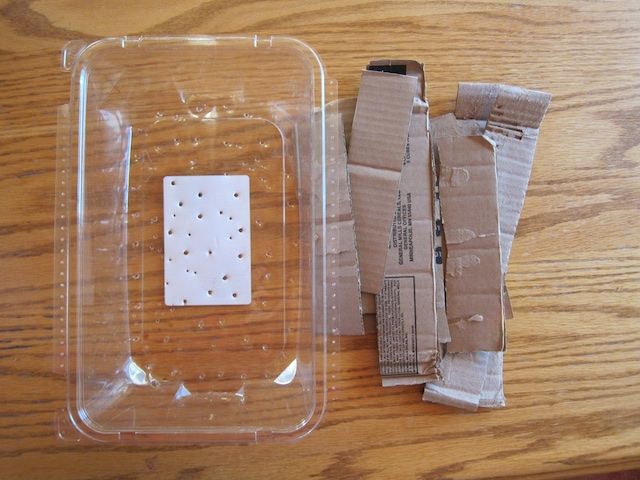naoki
Well-Known Member
In Japan, people have been successfully germinating some terrestrial orchids with cardboard for a long time. There are semi-scientific study about this, but none knows why the cardboard works. Actually, I started to put cardboard strips into the side wall of epiphytic orchids, too. I tried this method of propagation with my Dactylorhiza purpurella. I posted the photo of this plant in another thread. The parent came from Great Lakes Orchids. I didn't do hand pollination of this parent (which I'm calling 'NT3'), and I think that some insects did the work for me (they were growing outside). About 5 of them were flowering at the same time.
Sept 29, 2014:
The seeds were harvested when the three capsules naturally dehisced (or almost splitting) around Sept 29.
Oct 17, 2014: Cardboard sowing
potting soil from garden, coarse perlite, some small bark, sheet moss from backyard. Then placed in garage, which could go down to 40F. Around Jan, it was brought into the bedroom around 60-70/50-55F in the dark grow tent. Feb 26, lots of germination, about 0.5-2mm. some seems to have starrted root.
I made holes to the bottom of a salad container (about 30x20cm with 10cm height). Then cut up strips from a cardboard box.

Arranged the cardboard strips, and fill it with about 1.5" of dirt. I forgot the exact composition. I mixed potting soil (peat based) used for other plants previously and added a bit of coarse perlite (sponge rock). Maybe 2:1? Then I dug up some soil (organic layer, topsoil) from my backyard which is mixed Spruce, Poplar, Birch forest (as source of fungi) and mixed in (probably 1/10 of the total volume).

Then I sprinkled a little bit of live "sheet moss" which I found in my backyard.

Then I sprinkled orchid seeds with help of my 3 year old son.

Then I covered it with a lid, and set it in a tray of water. My helper's foot with a polar bear sock is in the photo, too!

I left it in the garage which is about 40F for about 2 months. Then I moved it indoor (55F) around the end of Jan. I noticed that mold was starting to grow at this time. I kept it completely dark indoor, and I have forgotten about it.
Feb 26. 2015:
After 1 month of darkness, this is what you get:




The protocomb is between 0.5-2.5mm. It appears that the root is starting to form (the first photo top right). I've heard that other people tried this with Dactylorhiza, and they also got the protocombs, but the growth after that was slow. So I still don't know if it will continue to grow, but I'll try to keep editing this original message to document the failure or success.
I was going to post it when the story is more complete, but I need some help from people with more experiences with European terrestrials. My question is that when is a good time to bring them out from the darkness. Any advise?
Sept 29, 2014:
The seeds were harvested when the three capsules naturally dehisced (or almost splitting) around Sept 29.
Oct 17, 2014: Cardboard sowing
potting soil from garden, coarse perlite, some small bark, sheet moss from backyard. Then placed in garage, which could go down to 40F. Around Jan, it was brought into the bedroom around 60-70/50-55F in the dark grow tent. Feb 26, lots of germination, about 0.5-2mm. some seems to have starrted root.
I made holes to the bottom of a salad container (about 30x20cm with 10cm height). Then cut up strips from a cardboard box.

Arranged the cardboard strips, and fill it with about 1.5" of dirt. I forgot the exact composition. I mixed potting soil (peat based) used for other plants previously and added a bit of coarse perlite (sponge rock). Maybe 2:1? Then I dug up some soil (organic layer, topsoil) from my backyard which is mixed Spruce, Poplar, Birch forest (as source of fungi) and mixed in (probably 1/10 of the total volume).

Then I sprinkled a little bit of live "sheet moss" which I found in my backyard.

Then I sprinkled orchid seeds with help of my 3 year old son.

Then I covered it with a lid, and set it in a tray of water. My helper's foot with a polar bear sock is in the photo, too!

I left it in the garage which is about 40F for about 2 months. Then I moved it indoor (55F) around the end of Jan. I noticed that mold was starting to grow at this time. I kept it completely dark indoor, and I have forgotten about it.
Feb 26. 2015:
After 1 month of darkness, this is what you get:




The protocomb is between 0.5-2.5mm. It appears that the root is starting to form (the first photo top right). I've heard that other people tried this with Dactylorhiza, and they also got the protocombs, but the growth after that was slow. So I still don't know if it will continue to grow, but I'll try to keep editing this original message to document the failure or success.
I was going to post it when the story is more complete, but I need some help from people with more experiences with European terrestrials. My question is that when is a good time to bring them out from the darkness. Any advise?












































